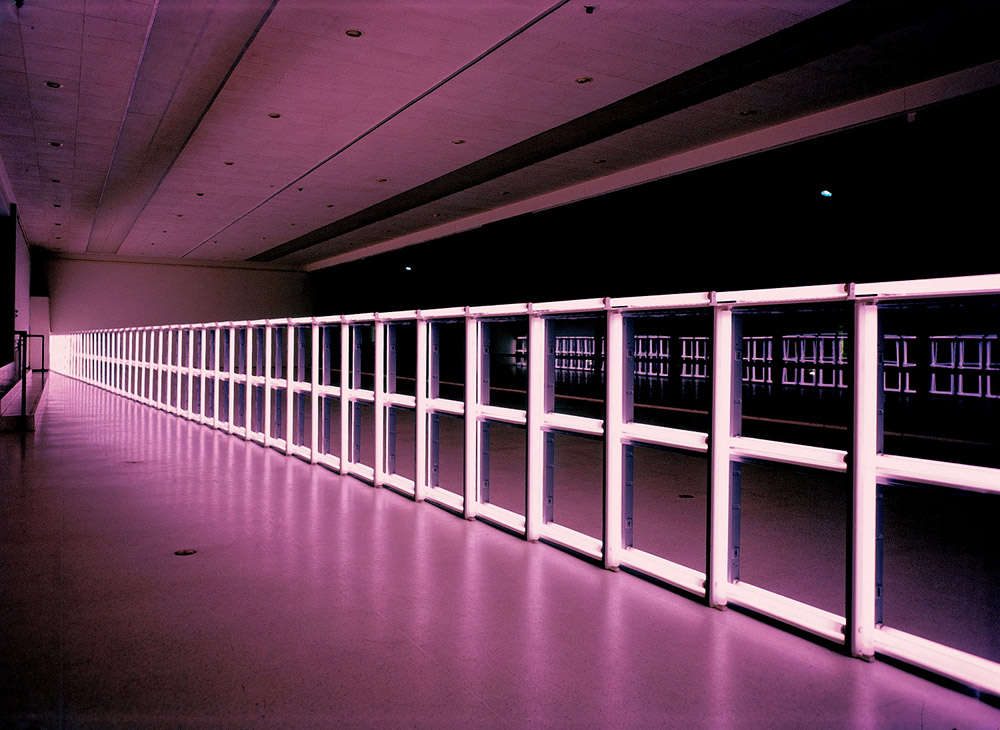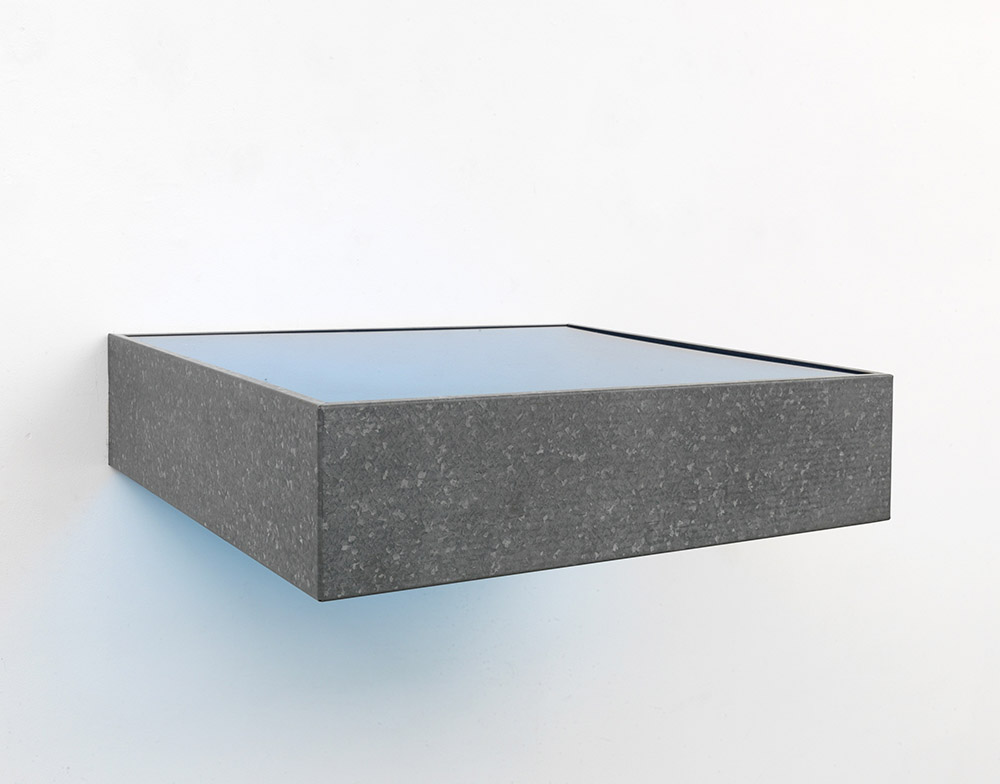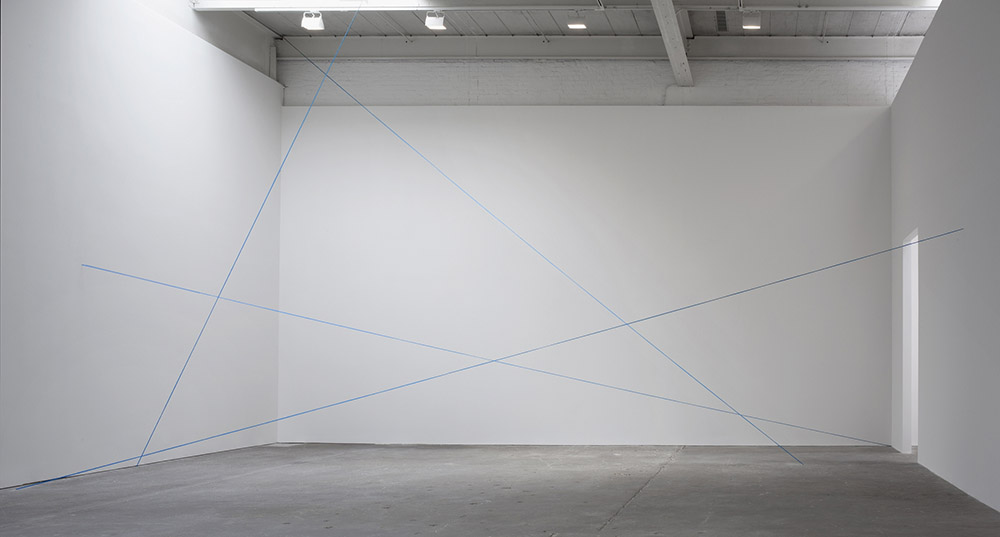ART-PRESENTATION: Flavin, Judd, McCracken, Sandback
 Minimalism can be seen as extending the abstract idea that art should have its own reality and not be an imitation of some other thing. We usually think of art as representing an aspect of the real world (a landscape, a person, or even a tin of soup!); or reflecting an experience such as an emotion or feeling. With minimalism, no attempt is made to represent an outside reality, the artist wants the viewer to respond only to what is in front of them. The medium, (or material) from which it is made, and the form of the work is the reality.
Minimalism can be seen as extending the abstract idea that art should have its own reality and not be an imitation of some other thing. We usually think of art as representing an aspect of the real world (a landscape, a person, or even a tin of soup!); or reflecting an experience such as an emotion or feeling. With minimalism, no attempt is made to represent an outside reality, the artist wants the viewer to respond only to what is in front of them. The medium, (or material) from which it is made, and the form of the work is the reality.
By Efi Michalarou
Photo: David Zwirner Gallery Archive
An exhibition of work by four American artists associated with Minimalism: Dan Flavin, Donald Judd, John McCracken and Fred Sandback, is on presentation at David Zwirner Gallery in Hong Kong. Each artist is represented by a focused presentation of his work in a single room, allowing visitors to experience both the commonalities and distinctions in the individual approaches to reductive form, material, color, and space. With the intention of creating straightforward work that could assume a direct material and physical “presence” without recourse to grand philosophical statements, Donald Judd eschewed the classical ideals of representational sculpture to create a rigorous visual vocabulary that sought clear and definite objects as its primary mode of articulation. Judd’s oeuvre has come to define what has been referred to as Minimal art, a label to which the artist strongly objected on the grounds of its generality. Throughout his career, he endeavored to produce objects that were entirely self-referential, writing in 1968, “A shape, a volume, a color, a surface is something itself. It shouldn’t be concealed as part of a fairly different whole”. Judd began his career as an art critic, continuing to write about the work of his peers throughout his career. His influential writings, including his now canonical essay “Specific Objects” published in 1965, grappled with questions of the moment, helping to define the art of his era. On view in this exhibition is a selection of Judd’s most significant and influential forms, including a “stack” in Cor-ten steel, six horizontally oriented units set equally apart, each of which juxtaposes the Cor-ten support with backing made from black acrylic sheets. Also presented is a “progression,” which consists of a series of stainless steel rectangular forms that are connected by a square, anodized aluminum pipe that is flush with the front and top edges of the work and mounted horizontally on a wall. Beginning in 1964, progressions based on various mathematical sequences became a central motif in Judd’s work, and he continued to make them throughout his career. From 1963, when he conceived the “diagonal of May 25, 1963 (to Constantin Brancusi)”, a single gold fluorescent lamp that is installed on a diagonal on the wall until his death in 1996, Dan Flavin produced a singularly consistent and prodigious body of work that utilized commercially available fluorescent lamps to create installations, or “situations” as he preferred to call them, of light and color. On view is a large-scale untitled “barrier” by the artist from 1974, shown here for the first time since its original presentation at the Museum Boymans-van Beuningen, Rotterdam, in 1975. The work cuts across the expanse of the gallery and dramatically bathes the space in pink fluorescent light, physically blocking access to part of the space and altering the viewer’s perception of the surrounding architecture. Flavin’s barriers, the first of which was executed in 1966, are among the artist’s most significant bodies of work. As site-specific, modular, and serial structures, these works demonstrate Flavin’s centrality to Minimal and Conceptual art movements of the 1960s and 1970s and moreover count among the earliest examples of what is now commonly referred to as “installation art”. John McCracken likewise occupies a singular position within the recent history of American art, as his work combines the restrained formal qualities of Minimalist sculpture with a distinctly Los Angeles sensibility expressed through color, form, and finish. McCracken developed his early sculptural work while studying painting at the California College of Arts and Crafts in Oakland in the late 1950s and early 1960s. While experimenting with increasingly three-dimensional canvases, the artist began to produce objects made with industrial materials, including plywood, sprayed lacquer, and pigmented resin, creating the highly reflective, smooth surfaces for which he was to become known. As he explained, “I think of color as being the structural material I use to build the forms I am interested in”. On view is a group of the artist’s “planks”, his signature sculptural form. First generated in 1966, these works comprise a narrow, monochromatic, rectangular board format that leans at an angle against the wall (the site of painting) while simultaneously entering into the three-dimensional realm and physical space of the viewer. Fred Sandback is known for sculptures that outline planes and volumes in space. Though he employed metal wire and elastic cord early in his career, the artist soon dispensed with mass and weight by using acrylic yarn to create works that address their physical surroundings, the “pedestrian space,” as Sandback called it, of everyday life. By stretching lengths of yarn horizontally, vertically, or diagonally at different scales and in varied configurations, the artist developed a singular body of work that elaborated on the phenomenological experience of space and volume with unwavering consistency and ingenuity. In his own words, Sandback described his sculpture as being “less a thing-in-itself, more of a diffuse interface between myself, my environment, and others peopling that environment, built of thin lines that left enough room to move through and around. Still sculpture, though less dense, with an ambivalence between exterior and interior. A drawing that is habitable”. On view is a rare work from Sandback’s “Mikado” series, begun in the 1990s, that occupies an entire room and is characteristic of the themes that the artist pursued throughout his career. Inspired by the chance-generated Mikado (pick-up-sticks) game, in which a bundle of colored sticks is released onto a playing surface, the work consists of seemingly random lengths of yarn that intersect each other in space, both occupying and exceeding the space of the viewer.
Info: David Zwirner Gallery, 5-6/F, H Queen’s, 80 Queen’s Road Central, Hong Kong, Duration: 15/11-21/12/18, Days & Hours: Tue-Sat 11:00-19:00, www.davidzwirner.com



